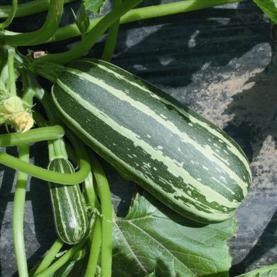As I’ve said before the garden at Knowle cottage was big, but not huge. It took some creative planting to make sure we produced enough to feed the family.
My Ern was a master at getting the most out of the garden. He rotated the crops every year, he would draw a simple plan of what was going to be planted where, moving everything over a plot from the year before.
Even so, unless he ‘doubled up’ we could not have grown enough to keep us fed, especially during the war years when food was even shorter than usual.
It was a simple system. He would plant things that were deep rooted and going to be in the ground for a long time, things like parsnips, onions and swede (ed. note: we call swede rutabaga) and as later in the season, when the crop was well underway she would sow quick growing crops such as spring onions, radish and turnip. This didn’t disturb the main crop and we got extra food from the same amount of ground.
Tomatoes take up a good bit of space so these were planted in old cider barrels under the window where the ground was rocky and not much use for owt else. (ed note: Devon dialect for anything)
Marrows grow quite happily on a compost heap so they were just sown down the bottom and were pretty much left alone. They grew really big and were very tasty. (ed note: like a zucchini on steroids, these things grow really big!)
The fruit bushes never moved. We had blackberries in the hedges around the edge of the garden, and redcurrant, blackcurrant and strawberries up a sunny corner. We had cooking apple trees and a cottage down the lane eating apple so when they were harvested we would swap, a basket of ours for a basket of theirs.
Every bit of ground had something in. We grew any amount of potatoes, they were a staple of our diet and Ern would plant a row every other week from spring to summer. The least ones would be dug up in October and be stored for winter. We had a barrel in the kitchen that Ern had cut a hole in on the side near the bottom. It was lined with newspaper and the potatoes would be put in there for use during the winter. Each layer would have a few sheets of newspaper between them. We blocked the hole with a rock to stop them all rolling out onto the floor.
Late harvested onions would have their stalks plaited together and they would be hung in the scullery for using out of season.
Beans would be left to dry overnight and wrapped in newspaper and stored in a box in the dark, next to the potato barrel if I recall correctly.
Some of the tomatoes would be sliced up and dried in the sun. I stored them in glass jars so I could use them in winter.
The fruit would be turned into jam, and bits of veg would be turned into chutney that we could eat throughout the winter.
It was a lot of hard work, but it was all we knew, and I have to say the food we grew tasted so much nicer than the stuff you get from the supermarkets these days.
Regards
Maud


I enjoyed your article as I enjoy gardening and having resources. I plant edibles everywhere. It doesn’t hurt my feelings at all to be prepared or to get virtually free food. I have a wide variety of fruit trees, berries, nuts, herbs, and veggies. I like to have something going every season. I have Japanese persimmons which ripen in October. I live in the southern US so we have a pretty long growing season. Last year I planted English plums as our native plums and Japanese plums ripen early. My English plums ripened in September. I have ten varieties of figs that I like to propagate and share with others..I like to have the bases covered and have things to share?